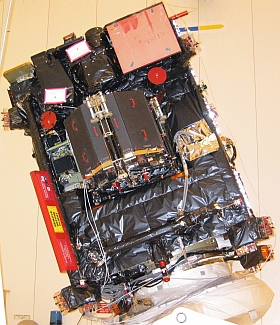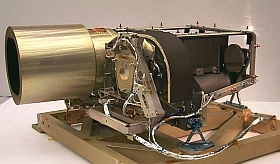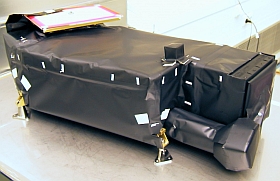|
|
|
 |
 OSIRIS
OSIRIS
|
|
|
OSIRIS
The Scientific Imaging System for Rosetta
Optical, Spectroscopic, and Infrared Remote Imaging System
 OSIRIS (Optical, Spectroscopic, and Infrared Remote Imaging System) is the main scientific imaging system on the orbiter of ESA's
OSIRIS (Optical, Spectroscopic, and Infrared Remote Imaging System) is the main scientific imaging system on the orbiter of ESA's  Rosetta mission to comet 67P/Churyumov-Gerasimenko. Rosetta mission to comet 67P/Churyumov-Gerasimenko.
OSIRIS comprises a high resolution Narrow Angle Camera (NAC) and a Wide Angle Camera (WAC). The NAC is designed to obtain high resolution images of the surface of comet 67P/Churyumov-Gerasimenko through 12 discrete filters over the wavelength range from 250 to 1000 nm at an angular resolution of 18.6 µrad/px. The WAC is optimised to provide images of the near nucleus environment in 14 discrete filters (240-720 nm) at an angular resolution of 101 µrad/px. Both cameras are equipped with 2048 x 2048 pixel CCD detectors, and have an off-axis optical configuration.
After the launch of Rosetta (2nd March 2004), OSIRIS was commissioned in seven slots between March 2004 and June 2005, and has been activated on several occasions before Rosetta arrives in 2014 at its main target, comet 67P/Churyumov-Gerasimenko. OSIRIS already performed several important scientific observations:
- A monitoring campaign of comet 9P/Tempel 1 around the Deep Impact event on 4 July 2005 [more]
- A swing-by manoevre at Mars on 26 February 2007 [more]
- The fly-by of asteroid 2867 Steins on 5 September 2008 [more]
- Two Earth swing-bys in Nov. 2007 and Nov. 2009
- The observation of the remnant of a collision between two main-belt asteroids in February 2010 [more]
- The fly-by of asteroid 21 Lutetia on 10 July 2010 [more]
- Early observation of the comet from more than 1AU distance in March 2011.
The OSIRIS cameras were provided by a consortium of 9 institutes from 5 European countries and from ESA, under the leadership of the the Max-Planck-Institute for Solar System Research (MPS) (Principal Investigator: Holger Sierks). The participating institutes of the consortium are:
MPS (Katlenburg-Lindau, Germany), LAM (Marseille, France), UPD (Padova, Italy), IAA (Granada, Spain), University of Uppsala (Sweden), ESTEC (ESA, Noordwijk, The Netherlands), UPM (Madrid, Spain), INTA (Madrid, Spain), IDA (Braunschweig, Germany) [more]
Science Objectives
The main objetive of OSIRIS is to study the physical and chemical processes that occur in, on, and near the cometary nucleus. In particular, OSIRIS allows researchers to determine the outflow of gas and dust from different regions of the cometary nucleus, and to compare active areas with deviations in surface mineralogy, in topography, and in local insolation. The main science objetives of OSIRIS are:
- characterise the size, shape, and density of the nucleus of comet 67P/Churyumov-Gerasimenko
- determine the rotational properties of the comet
- monitor the nucleus activity and evolution over many months at various scales
- study the chemical composition of the nucleus surface
- find a suitable landing spot for Philae, the Rosetta lander
The Instrument
The OSIRIS cameras are unobstructed mirror systems, equipped with two filter wheels containing 8 position each, and with backside illuminated CCD detectors comprising 2048 x 2048 pixels with a pixel size of 13.5 µm. Both cameras use identical image acquisition systems, consisting of the Focal Plane Assembly and the CCD Readout Box. The following two figures show the two OSIRIS cameras (NAC and WAC).
OSIRIS comprises two cameras:
-
 NAC (Narrow Angle Camera)
NAC (Narrow Angle Camera)
The Narrow Angle Camera is designed to obtain high-resolution images of the comet at distances from more than 500 000 km down to 1 km (resulting in a resolution of ~2 cm per pixel), and of the asteroids 2867 Steins and 21 Lutetia during the interplanetary cruise. The camera also should be able to detect small ejected particles close to the cometary nucleus (brightness ratio = 1/1000). The NAC is equipped with 12 filters to characterise the reflectivity spectrum of the nucleus surface over a wide spectral range from 250 to 1000 nm. The NAC has a square field of view (FOV) of 2.2 degrees, with an instantaneous field of view (IFOV) of 18.6 µ rad (3.8 arcsec) per pixel, and is a moderately fast system (f/8). The system has a 717 mm focal length. A flat-field, three anastigmatic mirror system is adopted. It has a mass of 13.2 kg.
-
 WAC (Wide Angle Camera)
WAC (Wide Angle Camera)
The principal objective of this camera is to study the intensity of gas emissions and dust-scattered sunlight as functions of position and viewing angle in the vicinity of the nucleus. The WAC is accomplished by 14 filters from 240 to 720 nm. Seven of the narrow band filters isolate gas emissions from the cometary coma; the others filters measure the dust continuum at wavelengths close to that of the gas emissions. The WAC has a FOV of 12x12 degrees, with an angular resolution of 101 µ rad (20.5 arcsec) per pixel, and is a system with a fast focal ratio of f/5.6. The system has a 140 (sag)/131 (tan) mm focal length. Two aspherical mirror system is adopted. It weighs 9.5 kg.
The Team
| Holger Sierks |
OSIRIS Principal Investigator |
+49 5556 979 242 |
 sierks@mps.mpg.de sierks@mps.mpg.de |
| Jessica Agarwal |
Associate Scientist |
| Colin Snodgrass |
Associate Scientist |
| Cecilia Tubiana |
Associate Scientist |
| Jean-Baptiste Vincent |
Associate Scientist |
| Nilda Oklay |
Associate Scientist |
| Pablo Gutierrez-Marques |
Instrument Operation Manager |
| Irene Büttner |
Ground Segment Engineering |
| Ian Hall |
Programmer |
| Marc Hofmann |
Ph.D. Student |
| Sebastian Höfner |
Ph.D. Student |
| Jacob Deller |
Ph.D. Student |
| Michael Richards |
Quality Assurance |
| Daniel Maase |
Computer Maintenance |
| Fee von Saltzwedel |
Secretary |
Related Press Releases
 |
Primal rock in space
Press Release 23/2011 - October 28, 2011
The Lutetia asteroid could be a remnant from the early phase of the solar system.
Lutetia is a real fossil: several areas of the asteroid's surface are around 3.6 billion years old and thus some of the oldest in the planetary system. Its high density means Lutetia is also a planetesimal, the first stage of development on the way to becoming a planet. These findings have been obtained by scientists headed by the ...
[more]
|
 |
Rosetta's first glimpse of the comet
Press Release 13/2011 - June 8, 2011
Three years before its arrival the camera system on board the space probe Rosetta renders the first images of its destination.
Approximately 163 million kilometers still separate ESA's spacecraft Rosetta from comet Churyumov-Gerasimenko, its 2014 target. Despite this remarkable distance, scientists from the Max Planck Institute for Solar System Research (MPS) in Germany have succeeded in obtaining the first images of the remote destination using the onboard camera system OSIRIS. These ...
[more]
|
 |
Rosetta's unique view of an asteroid collision
Press Release 13/2010 - October 13, 2010
Scientists from the Max Planck Institute for Solar System Research use the unique perspective from the Rosetta spacecraft to date impact.
In the first half of February 2009 two asteroids collided in a region of space beyond the orbit of Mars, as scientists from the Max Planck Institute for Solar System Research (MPS) in Germany have now discovered. The researchers were able to pinpoint the exact date of the impact ...
[more]
|
 |
Erste Bilder des Asteroiden Lutetia
Press Release 09/2010 - July 10, 2010
Eine Weltraum-Kamera vom Max-Planck-Institut für Sonnensystemforschung entdeckt eine neue Welt.
Die ESA-Raumsonde Rosetta ist am Samstag, 10. Juli, gegen 18 Uhr an dem Asteroiden Lutetia vorbeigeflogen. Bilder dieses einzigartigen Ereignisses hat das Kamerasystem OSIRIS aufgenommen, das unter Leitung des Max-Planck-Instituts für Sonnensystemforschung (MPS) im niedersächsischen ...
[more]
|
 |
Rendezvous mit einem Riesenbrocken
Press Release 08/2010 - July 6, 2010
Das Kamerasystem OSIRIS bereitet die Raumsonde Rosetta auf ihre Begegnung mit dem Asteroiden Lutetia vor.
Auf eine besondere Begegnung steuert die ESA-Raumsonde Rosetta am Samstag, 10. Juli, gegen 18 Uhr zu. Nur etwa 3000 Kilometer werden die Raumsonde dann von dem Asteroiden Lutetia trennen. Mit einem Durchmesser von etwa 100 Kilometern ist Lutetia bei Weitem der ...
[more]
|
 |
Diamant im All
Press Release 01/2010 - January 7, 2010
Mit der OSIRIS-Kamera an Bord der Raumsonde Rosetta enthüllen Forscher die Gestalt des Asteroiden Steins.
Im Fernrohr ist der Kleinplanet Steins ein unscheinbares Lichtpünktchen. Bei näherem Hinsehen entpuppt er sich als eine Art Schutthalde mit diamantähnlicher Form und großen Kratern auf der Oberfläche. Näher hingesehen hat ein Team um Horst Uwe Keller vom Max-Planck ...
[more]
|
 |
Die "Augen" der Raumsonde ROSETTA fotografieren die Erde aus dem All
Press Release 11/2009 - November 17, 2009
Kamera vom Max-Planck-Institut für Sonnensystemforschung an Bord der Raumsonde Rosetta liefert spektakuläre Bilder während des Vorbeifluges an der Erde.
Die ESA-Raumsonde Rosetta flog am 12. November 2009 mit einer Geschwindigkeit von 50.000 km/h an der Erde vorbei. Diesen Vorbeiflug nutzten die Wissenschaftler aus dem Max-Planck-Institut für ...
[more]
|
 |
Erste Bilder des Asteroiden Steins
Press Release 14/2008 - 8th September 2008
Eine Weltraum-Kamera vom Max-Planck-Institut für Sonnensystemforschung entdeckt tiefe Krater auf der Oberfläche des Asteroiden.
Die ESA-Raumsonde Rosetta ist in der vergangenen Nacht in nur 800 Kilometern Entfernung an dem Asteroiden Steins vorbeigeflogen. Mit Hilfe des Kamerasystems OSIRIS, das unter Leitung des Max-Planck-Instituts für Sonnensystemforschung (MPS) entwickelt wurde, sind spektakuläre ...
[more]
|
 |
Eine Kamera navigiert durchs All
Press Release 12/2008 - 28th August 2008
Das Gerät vom Max-Planck-Institut für Sonnensystemforschung bereitet die Raumsonde Rosetta auf ihre Begegnung mit einem Asteroiden vor.
Die ESA-Raumsonde Rosetta fliegt am Freitag, 5. September, an einer besonderen "Sehenswürdigkeit" vorbei: Nur etwa 800 Kilometer werden die Sonde vom Asteroiden Steins trennen. Die Begegnung bietet Forschern erstmals die Gelegenheit, einen Asteroiden dieses Typs aus ...
[more]
|
 |
First OSIRIS images from Rosetta Earth swing-by
Press Release 15/2007 - 15th November 2007
During its 10 year cruise to comet Churyumov-Gerasimenko ESA’s Rosetta spacecraft performs four planetary (3 times Earth, once Mars) and 2 asteroid flybys. After the successful Mars swing-by in Feb. 2007, the second Earth swing-by took place in the evening of Nov. 13. The scientific camera system OSIRIS, built by an European consortium lead by MPS, observed the earth during the swing-by of the Rosetta spacecraft. First images are ...
[more]
|
 |
OSIRIS collected spectacular images of Mars during the Rosetta flyby
Press Release 02/2007 - 26th February 2007
An important observing opportunity of OSIRIS, before Rosetta arrives at 67P/Churyumov-Gerasimenko in 2014, is the Mars swing-by. Rosetta requires the Mars flyby to gain acceleration on a complicated trajectory. OSIRIS was actived during this close fly-by of Mars, and acquired beautiful images of the red planet on 24 February. Due to the unique dynamic range and the filters of OSIRIS, new valuable information about Mars is expected....
[more]
 |
Kameras auf Rosetta messen Lichtkurven der Rosetta-Asteroiden
Press Release 01/2007 - 5th February 2007
Als der Start von ESAs Kometenmission Rosetta, ursprünglich für Januar 2003 geplant, um ein Jahr verschoben wurde, mussten die wissenschaftlichen Ziele neu ausgewählt werden. Der Komet Churyumov-Gerasimenko wurde schließlich als neues "Hauptziel" für ein Rendezvous im Jahr 2014 bestimmt, mit Vorbeiflügen an den Asteroiden (2867) Steins im September 2008 und (21) Lutetia im Juli 2010. Um die Vorbeiflüge an den Asteroiden und ...
[more]
|
 |
Max-Planck-Forscher beobachten Auswirkungen des Einschlags auf dem Kometen Tempel 1
Press Release 06/2005 - 5th July 2005
Das Kamerasystem OSIRIS auf der Raumsonde ROSETTA misst dramatischen Helligkeitsanstieg.
Am 04. Juli um 7:52 mitteleuropäischer Sommerzeit schlug ein Kupfer-Projektil in den Kometen Tempel 1 ein, das von der NASA-Raumsonde Deep Impact zuvor abgefeuert wurde.
An der internationalen Kampagne zur Beobachtung der Folgen des Einschlags auf den Kometen nahm auch die ...
[more]
|
 |
Max-Planck Forscher beobachten Beschuss des Kometen Tempel
Press Release 05/2005 - 27th June 2005
Am 4. Juli 2005, 7:52 Uhr MESZ wird die NASA-Raumsonde "Deep Impact" einen 370 kg schweren Kupferblock mit einer Geschwindigkeit von 37100 km/h auf den Kometen 9P/Tempel 1 schießen.
Die Kollision, die etwa 4.5 Tonnen TNT entspricht, wird von der Raumsonde selbst, aber auch von vielen Stationen auf der Erde, vom Weltraumteleskop Hubble und der Raumsonde Rosetta beobachtet werden.
[more]
|
 |
ESA-Mission "Rosetta" vor dem Start
Press Release 01/2004 - 10th February 2004
Am 26. Februar 2004 um 4.16 Uhr oder 4.36 Uhr Ortszeit (8.16 Uhr oder 8.36 Uhr Mitteleuropäische Zeit) soll von Kourou in Französisch-Guayana aus die ESA-Mission "Rosetta" zu einer spektakulären Kometenmission starten.
Die Raumsonde besteht aus zwei Teilen - dem Orbiter "Rosetta" und einem integrierten Landegerät, das erst vor wenigen Tagen "Philae" getauft wurde. Beide treten ihren Flug gemeinsam an und sollen sich nach einer ...
[more]
|
Related links
Member institute homepages
|
|
|
|
|
